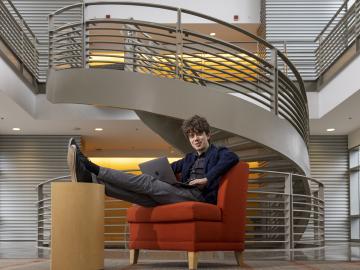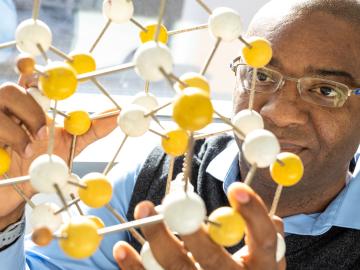
Filter News
Area of Research
- (-) Materials (34)
- (-) Supercomputing (9)
- Advanced Manufacturing (1)
- Biology and Environment (44)
- Chemistry and Physics at Interfaces (1)
- Clean Energy (78)
- Data (1)
- Energy Frontier Research Centers (1)
- Functional Materials for Energy (1)
- Fusion and Fission (7)
- Isotope Development and Production (1)
- Isotopes (9)
- Materials Synthesis from Atoms to Systems (1)
- Materials Under Extremes (1)
- National Security (16)
- Neutron Science (8)
- Nuclear Science and Technology (5)
- Renewable Energy (1)
- Sensors and Controls (1)
News Type
News Topics
- Big Data (1)
- Bioenergy (1)
- Chemical Sciences (2)
- Climate Change (2)
- Computer Science (3)
- Energy Storage (1)
- Environment (3)
- Exascale Computing (1)
- Frontier (1)
- Fusion (1)
- High-Performance Computing (3)
- Materials (4)
- Materials Science (6)
- Microscopy (3)
- Nanotechnology (4)
- Neutron Science (2)
- Nuclear Energy (2)
- Physics (6)
- Polymers (2)
- Quantum Computing (1)
- Simulation (1)
Media Contacts

When Addis Fuhr was growing up in Bakersfield, California, he enjoyed visiting the mall to gaze at crystals and rocks in the gem store.

Gang Seob “GS” Jung has known from the time he was in middle school that he was interested in science.

The world is full of “huge, gnarly problems,” as ORNL research scientist and musician Melissa Allen-Dumas puts it — no matter what line of work you’re in. That was certainly the case when she would wrestle with a tough piece of music.

An international problem like climate change needs solutions that cross boundaries, both on maps and among disciplines. Oak Ridge National Laboratory computational scientist Deeksha Rastogi embodies that approach.

Marcel Demarteau is director of the Physics Division at the Department of Energy’s Oak Ridge National Laboratory. For topics from nuclear structure to astrophysics, he shapes ORNL’s physics research agenda.

Systems biologist Paul Abraham uses his fascination with proteins, the molecular machines of nature, to explore new ways to engineer more productive ecosystems and hardier bioenergy crops.

In the search to create materials that can withstand extreme radiation, Yanwen Zhang, a researcher at the Department of Energy’s Oak Ridge National Laboratory, says that materials scientists must think outside the box.

In the Physics Division of the Department of Energy’s Oak Ridge National Laboratory, James (“Mitch”) Allmond conducts experiments and uses theoretical models to advance our understanding of the structure of atomic nuclei, which are made of various combinations of protons and neutrons (nucleons).

Joe Paddison, a Eugene P. Wigner Fellow at the Department of Energy’s Oak Ridge National Laboratory, believes there’s more information to be found in neutron scattering data than scientists like himself might expect.

Valentino (“Tino”) Cooper of the Department of Energy’s Oak Ridge National Laboratory uses theory, modeling and computation to improve fundamental understanding of advanced materials for next-generation energy and information technologies.


